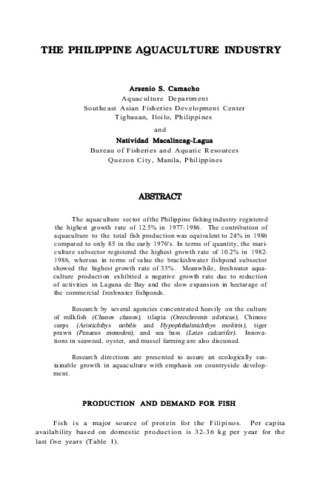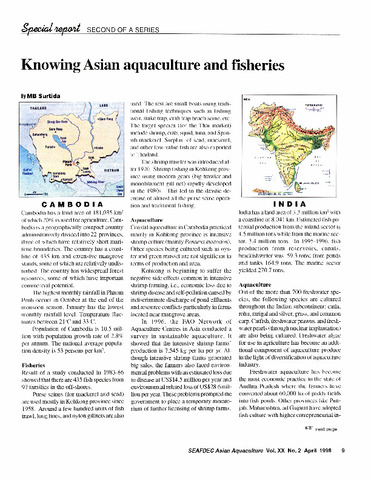| dc.contributor.author | Triño, Avelino T. | |
| dc.contributor.author | Primavera, Jurgenne | |
| dc.contributor.editor | Garcia, Luis Maria B. | |
| dc.date.accessioned | 2011-06-22T09:35:59Z | |
| dc.date.available | 2011-06-22T09:35:59Z | |
| dc.date.issued | 2001 | |
| dc.identifier.citation | Primavera, J. H., & Triño, A. T. (2001). Mangrove-friendly aquaculture studies at the SEAFDEC Aquaculture Department. In L. M. B. Garcia (Ed.), Responsible Aquaculture Development in Southeast Asia. Proceedings of the Seminar-Workshop on Aquaculture Development in Southeast Asia organized by the SEAFDEC Aquaculture Department, 12-14 October 1999, Iloilo City, Philippines (pp. 231-239). Tigbauan, Iloilo, Philippines: Aquaculture Department, Southeast Asian Fisheries Development Center. | en |
| dc.identifier.isbn | 9718511474 | |
| dc.identifier.uri | http://hdl.handle.net/10862/475 | |
| dc.description.abstract | The SEAFDEC Aquaculture Department studies on mangrove-friendly aquaculture (MFA) can be categorized under two models: a) mangrove filters where mangrove forests are used to absorb effluents from high-density culture ponds, and b) aquasilviculture or the low-density culture of crabs, shrimp and fish integrated with mangroves. In a study using the first model, shrimp pond effluents were retained in an enclosed mangrove area prior to release to receiving waters. Nutrients and other water quality parameters, and bacterial levels were monitored in the untreated effluents and post-mangrove water.
In the second MFA model, mangrove pens and ponds installed in old growth and newly regenerating mangrove sites in Aklan, central Philippines were stocked with mud crab Scylla olivacea/S. tranquebarica and shrimp Penaeus monodon. Investment costs, survival and production, and cost-return analysis for the pens and ponds are reported in the paper. Aside from the aquasilviculture trials in collaboration with local government units, other activities in the Aklan mangrove sites are the survey and mapping of the 75-ha area in Ibajay, construction of a treehouse, and the educational use as field site by Coastal Resource Management trainees of SEAFDEC Aquaculture Department and field biology students of the University of the Philippines in the Visayas. | en |
| dc.language.iso | en | en |
| dc.publisher | Aquaculture Department, Southeast Asian Fisheries Development Center | en |
| dc.subject | Penaeus monodon | |
| dc.subject | Scylla olivacea | |
| dc.subject | Scylla tranquebarica | |
| dc.subject | Philippines | en |
| dc.subject | South East Asia | en |
| dc.subject.lcc | VF SP 0280 | |
| dc.title | Mangrove-friendly aquaculture studies at the SEAFDEC Aquaculture Department | en |
| dc.type | Conference paper | en |
| dc.citation.spage | 231 | |
| dc.citation.epage | 239 | |
| dc.subject.asfa | aquaculture development | en |
| dc.subject.asfa | aquaculture economics | en |
| dc.subject.asfa | aquaculture systems | en |
| dc.subject.asfa | crab culture | en |
| dc.subject.asfa | Experimental research | en |
| dc.subject.asfa | mangrove swamps | en |
| dc.subject.asfa | shrimp culture | en |
| dc.citation.conferenceTitle | Responsible Aquaculture Development in Southeast Asia. Proceedings of the Seminar-Workshop on Aquaculture Development in Southeast Asia organized by the SEAFDEC Aquaculture Department, 12-14 October 1999, Iloilo City, Philippines | en |
| dc.subject.scientificName | Penaeus monodon | |



